Steam heating in a private house: the principle of the system and analysis of possible implementation schemes
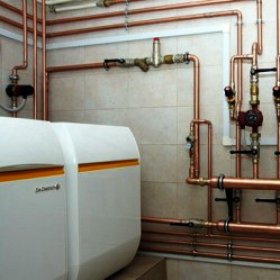
Private housing construction, which are used all year round, in addition to water supply and sewerage are provided with heating systems. The indisputable advantage of autonomous heating is an individual decision on the beginning and end of the heating season. There may be several options for arranging the system. Steam heating in a private house is one of the oldest methods of maintaining a comfortable temperature in cold weather. There are several varieties of the implementation of an autonomous steam heating system, from which you can choose the most suitable.
Components and principle of operation of the steam system
Regardless of the implementation scheme, steam heating has the following structural components: a heat source - a steam generator, a pipeline, heating elements, instrumentation and locking and regulating parts.
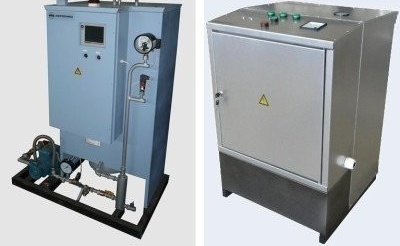
An electric steam generator may be selected as a heat source. It is enough to set the required parameters in the menu and enjoy a comfortable temperature
The pipeline is divided into steam pipe and condensate pipe. First, steam is supplied to the system. The second is condensate. Condensate pipelines, depending on the method of condensate movement, can be:
- gravity, with pipeline laying with a bias towards the storage tank.
- pressure head, the movement of condensate is caused by a difference in pressure.
Depending on the fullness, the condensate line is:
- dry, during the operation of the system, the pipe is partially filled with water;
- wet, the condensate line is constantly filled with water.
Unlike water heating, steam heating systems have the following disadvantages:
- the presence of noise during operation;
- too hot surface of the heating elements;
- difficult to regulate heat transfer of heating elements;
- less durable than water heating systems.
Important. When using steam heating, the surface of the heating elements at times approaches 100 ° C. Therefore, you need to be careful, otherwise you can get a burn.
And also advantages:
- small sizes of the components of the heating system;
- high heat dissipation of heating elements;
- fast heating of the room;
- steam is delivered to any point in the system without losing its heating ability;
- profitability.
In the process of heating water in the heat source, steam is released. When it condenses, heat is released. Steam is transferred through the steam lines to the heating elements, where it heats the walls of appliances through condensation, which give off heat to the room. After that, the condensate is sent to the collection tank, and then by gravity or by means of a pump is discharged into the boiler for subsequent heating. After which the whole process is repeated. In order to avoid the oncoming movement of condensate, the slope of the line is carried out in the direction of steam movement.To prevent steam from entering the condensate pipe, retaining washers or steam traps are used.
This is what a classic solid fuel steam generator looks like:
Various schemes for implementing steam heating
To do steam heating with your own hands, you need to know what options can be implemented.
Closed and open piping
Depending on the method of returning the condensate to the heat source, there are two options for steam heating: closed and open.
In a closed system, the condensate from the heating elements is returned to the heat source under the influence of the pressure difference. For the effective operation of such a system, it is necessary that the steam collector is placed low enough in relation to the heating elements.
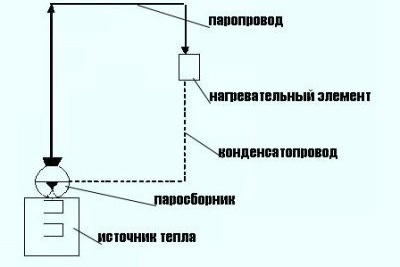
In order for steam heating with a closed system to work fully, you need to place the steam collector so that it is below the heating elements
An open system assumes gravity flow of condensate into the storage tank. From where periodically there is a transfer to a heat source using a pump. Such a system should be ensured by the free flow of condensate from the last heating element into the storage tank.
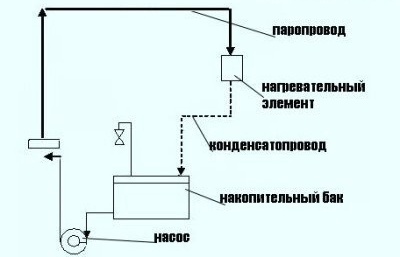
In an open steam heating system, the condensate line exiting the last heating element must be inclined with respect to the storage tank
Two-pipe or single-pipe system?
Depending on the method of supplying pipes to the devices, steam heating is divided into single-pipe and two-pipe. Due to the complexity of regulating heat flow single pipe system Steam heating is rarely used. For control, you have to purchase special devices, which increases the cost of work. Much easier to adjust double pipe heating system. At the steam inlet to the heater, a control valve is installed. At the condensate outlet - thermostatic steam traps. Thanks to this, the two-pipe system is less noisy than the one-pipe system.
Focus on system pressure
Division of steam heating systems depending on pressure:
- low pressure, closed and open;
- high pressure;
- vacuum steam.
Different schemes of steam systems differ in the way radiators are connected, the location of steam and condensate pipelines. Consider the option of a low pressure system. The pressure arising in the boiler promotes the movement of steam, which enters the riser, and then into the distributing steam line. The risers leading to the heating elements depart from it. Steam radiators with control valves are connected to the radiators. The steam enters the heating elements, is cooled from contact with the walls of the device, giving off heat. In the process, condensate is released, which is sent again through the condensate lines to the boiler.
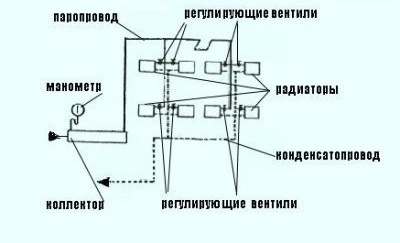
Low pressure steam heating systems are equipped with pressure gauges that help control the pressure in the system. A fuse must be installed on the boiler
High pressure systems at the starting point of the steam line have a vapor pressure above 0.7 kgf / cm². They are only closed loop. Consider one of the options for implementing such a system. The formed steam is reduced and sent to the distribution comb. It also installs a safety valve that controls the pressure within the set. A bypass is installed to repair it.
Then the steam goes through the risers to the heating elements. The pressure in the system must be sufficient to remove the condensate, since its temperature is almost equal to the temperature of the vapor. The steam line at the inlet and the condensate line at the outlet of the radiators are equipped with valves. A pressure gauge is installed to control the pressure. Compensators are provided on the pipeline to compensate for temperature elongations.
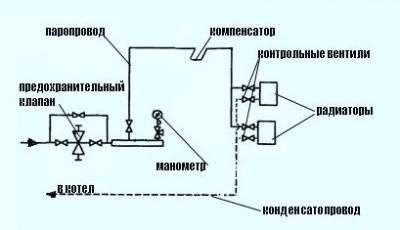
Heating elements must be equipped with control valves at the steam inlet to the radiator. Thermostatic steam traps are installed at the outlet to the condensate line
Vacuum-steam systems operate with a pump. It contributes to the creation of low pressure in the boiler and the movement of steam, and subsequently condensate through the system.
We use an existing stove
In houses where there is already a stove, you can conduct steam heating using it. The rules for installing and wiring the pipeline are the same as in other cases. However, steam heating from the furnace implies the absence of heating elements in the room into which the pipe exits. An exception is premises with an area of more than 40 m².
Installation of steam heating requires exact adherence to technology. In this case, it is necessary to make complex calculations, take into account all the subtleties of the process. If the work is done independently, it is better to entrust the calculation to professionals. This is the only way to achieve efficient steam heating.
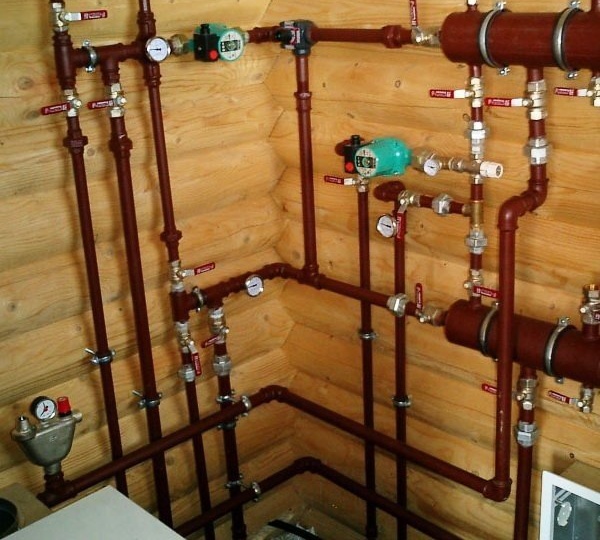

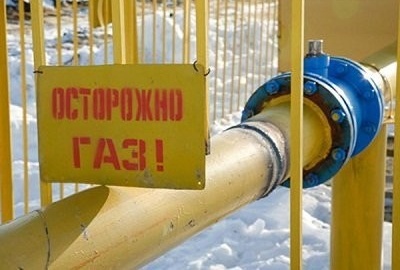
1 comment